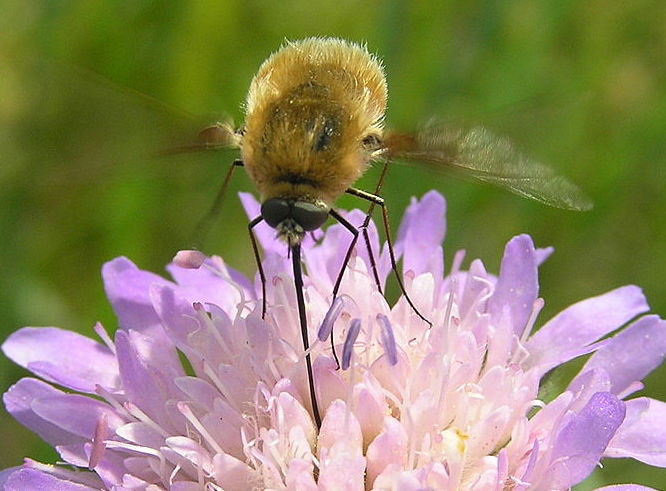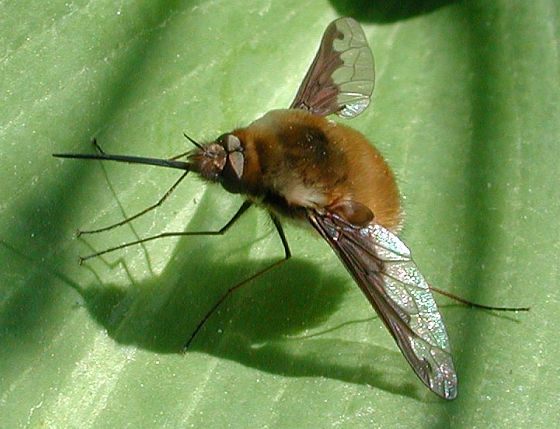- Home
- Garden Wildlife
- Insects
- True flies
- Bee flies
Bee flies
Bee flies belong the family Bombyliidae. The larvae of most species develop as larvae in the nests of solitary bees and wasps but some species have larvae that are internal parasitoids of moth caterpillars. The adults often resemble bees, an example of Batesian mimicry.
Species in Britain and Ireland
There are nine species of bee fly in Britain and Ireland. Most are uncommon insects mainly confined to southern England. The one species that is widespread and common is the dark-edged bee fly, Bombylius major. This has a stout body covered with tawny brown hairs and is 10-12mm long. It can be mistaken for a small bumblebee but it has short antennae and of course lacks a pair of hind wings. The common name refers to a scalloped, dark brown coloured area on the front edge of the wing, which contrasts strongly with an otherwise transparent wing. This feature is only visible when the fly is at rest. In flight, the wing movement is too rapid for the dark marking to be seen. Be aware that some hoverflies are also uncannily good mimics of bumblebees.
Biology
Bombylius major is active on warm sunny days in late March-May. It visits flowers to feed on nectar and its rapid wing movements allow it to hover in front of flowers like a humming-bird, making a buzzing sound. There is a rigid tube-like proboscis about 7mm long that projects prominently forward from the head. This enables the bee fly to reach deep into flowers to obtain nectar. Many types of flower can be visited but primrose Primula vulgaris and Aubrieta seem to be particular favourites in gardens.
Life cycle
This bee fly develops as a larva in the nests of ground-nesting solitary bees, particularly Andrena species. Eggs are laid while the bee fly hovers above places where solitary bees are likely to be making their nests. Eggs are released singly and flicked down towards the bee nesting area. The female fly has a cavity underneath the rear end of her abdomen that she fills with dust particles collected from dry soil. The sticky eggs get coated with dust before release, which makes them heavier and probably increases the chances of the eggs reaching the intended target area.
After hatching, the fly larvae crawl around and some find their way into suitable solitary bee nests, where they remain inactive until the bee larvae are almost fully grown. At that stage the bee fly larva starts feeding as an external parasite on a bee larva, which is eventually killed. Bombylius major overwinters in the soil as pupae, which wriggle to the surface when the adult flies are ready to emerge.
Role of bee flies in gardens
Like the sound of a cuckoo, the sight of dark-edged bee flies visiting garden flowers is a sign that spring has arrived. Bee flies are a natural predator of solitary bees and do not endanger populations. The adult fly’s method of sipping nectar through its long proboscis while hovering in flight in front of a flower probably means that it is less effective as a pollinating insect compared to insects that alight on flowers.
Other sources of information
Websites
Steve Falk’s images and information on bee flies
Soldierflies and allies recording scheme
Books
Stubbs, A. & Drake, M. (2014) British soldierflies and their allies. British Entomological and Natural History Society
Page drafted by Andrew Halstead, reviewed by Andrew Salisbury, edited by Steve Head


Bee flies
Bee flies belong the family Bombyliidae. The larvae of most species develop as larvae in the nests of solitary bees and wasps but some species have larvae that are internal parasitoids of moth caterpillars. The adults often resemble bees, an example of Batesian mimicry.
Species in Britain and Ireland
There are nine species of bee fly in Britain and Ireland. Most are uncommon insects mainly confined to southern England. The one species that is widespread and common is the dark-edged bee fly, Bombylius major. This has a stout body covered with tawny brown hairs and is 10-12mm long. It can be mistaken for a small bumblebee but it has short antennae and of course lacks a pair of hind wings. The common name refers to a scalloped, dark brown coloured area on the front edge of the wing, which contrasts strongly with an otherwise transparent wing. This feature is only visible when the fly is at rest. In flight, the wing movement is too rapid for the dark marking to be seen. Be aware that some hoverflies are also uncannily good mimics of bumblebees.


Biology
Bombylius major is active on warm sunny days in late March-May. It visits flowers to feed on nectar and its rapid wing movements allow it to hover in front of flowers like a humming-bird, making a buzzing sound. There is a rigid tube-like proboscis about 7mm long that projects prominently forward from the head. This enables the bee fly to reach deep into flowers to obtain nectar. Many types of flower can be visited but primrose Primula vulgaris and Aubrieta seem to be particular favourites in gardens.
Life cycle
This bee fly develops as a larva in the nests of ground-nesting solitary bees, particularly Andrena species. Eggs are laid while the bee fly hovers above places where solitary bees are likely to be making their nests. Eggs are released singly and flicked down towards the bee nesting area. The female fly has a cavity underneath the rear end of her abdomen that she fills with dust particles collected from dry soil. The sticky eggs get coated with dust before release, which makes them heavier and probably increases the chances of the eggs reaching the intended target area.
After hatching, the fly larvae crawl around and some find their way into suitable solitary bee nests, where they remain inactive until the bee larvae are almost fully grown. At that stage the bee fly larva starts feeding as an external parasite on a bee larva, which is eventually killed. Bombylius major overwinters in the soil as pupae, which wriggle to the surface when the adult flies are ready to emerge.
Role of bee flies in gardens
Like the sound of a cuckoo, the sight of dark-edged bee flies visiting garden flowers is a sign that spring has arrived. Bee flies are a natural predator of solitary bees and do not endanger populations. The adult fly’s method of sipping nectar through its long proboscis while hovering in flight in front of a flower probably means that it is less effective as a pollinating insect compared to insects that alight on flowers.
Other sources of information
Websites
Soldierflies and allies recording scheme
Books
Stubbs, A. & Drake, M. (2014) British soldierflies and their allies. British Entomological and Natural History Society
Page drafted by Andrew Halstead, reviewed by Andrew Salisbury, edited by Steve Head












